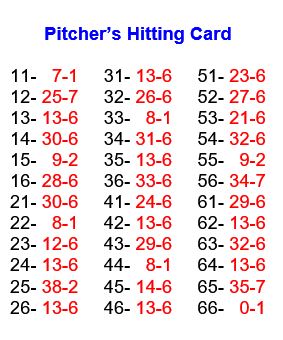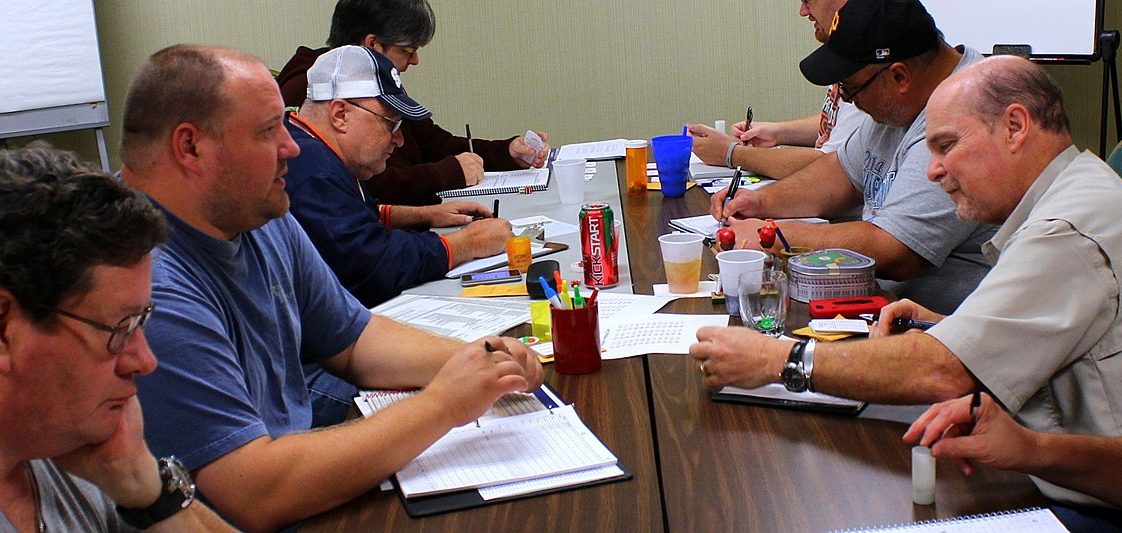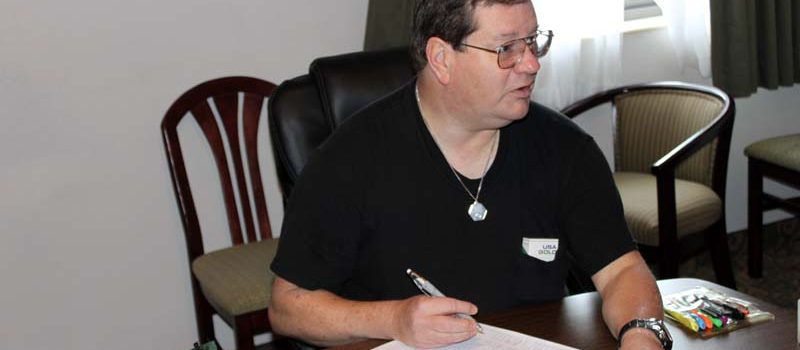1. ORGANIZATION
A. The name is derived from the two states (Illinois and Iowa) of the original members.
B. Purpose
1) To have fun in friendly competition.
2) To obtain realism in statistics.
2. MEMBERSHIP REQUIREMENTS
A. Each member shall strictly comply with all league rules and dates set forth in this constitution. The manager shall be timely and fair in all league activities.
B. Each manager shall comply with all instructions and manage opposing teams to their best advantage where instructions are unclear and nonexistent.
C. Each manager shall vote on all league matters requiring a vote and otherwise participate in all league activities.
D. Each manager shall pay dues as set forth by the league president. ($20.00)
E. Failure to observe any of the rules shall constitute cause for reprimand, forfeiture, and or expulsion.
F. The President shall be the arbitrator on any problem, unless directly involved, in which case the Vice-President shall arbitrate. All members shall abide by the decision. Appeals may be made at league meetings where a 75% vote is required to overturn the decision.
3. GENERAL RULES
A. Games and cards
1) The league shall use the regular APBA game cards (30 players per MLB team) that the league will purchase each year.
2) The league shall use the “APBA” basic game boards (2006), including the advanced rules and those set forth in this constitution.
3) If both managers agree the “Master Game” or “Computer Game” may be used for an entire series.
B. Amendments
1) Amendments may be made at the All-Star convention for the following season by a majority vote.
2) Proposals to be made in advance of the All-Star convention via E-Mail.
C. The season shall consist of 162 games. A balanced schedule will be used.
1) Two 9-game series against each team within your playing region.
2) Three 6-game series against each team outside your playing region.
4. RULES OF PLAY
A. Charts
1) With the “Bases Empty” the play result of “18” is changed to ground out if the shortstop is rated a “10”. With the “Bases Empty” the play result “20” is changed to ground out if the second baseman is rated a “9”. With the “Bases Empty” the play result “19” is changed to ground out if the third baseman is rated “6”.
2) All pitchers that have less than 10 At Bats will use a “Pitchers Hitting Card” until the year 2018. Please see accompanying card.
?
Pitcher’s Hitting Card

B. Limits
1) Non-Pitchers shall be restricted to their actual number of games and at-bats for the season being played.
2) Players are restricted to positions in the following manner.
a) The first position listed on a player’s card is unlimited except for Rule 4.B.1.
b) If a player played 20 games (inclusive) or more at a position he is unlimited except for Rule 4.B.1.
c) If a player played 10 to 19 games (inclusive) at a position he may play 40 games at that position except for Rule 4.B.1.
d) If a player played 1 to 9 games (inclusive) at a position he may play 10 games at that position except for Rule 4.B.1.
e) If a player has a position on his card that he did not play he may play 1 game at that position.
f) If a player played a position not listed on his card he is rated according to the “APBA” boards and is limited by rules 4.B.1, 4.B.2.a, 4.B.2.b, 4.B.2.c and 4.B.2.d.
g) If due to an injury a player is required to play a position not on his card he is allowed to play without penalty at the lowest rating for that position.
3) Pitchers are restricted as follows
a) Graded pitchers are limited to their actual number of starts, relief appearances, and innings pitched.
b) “D” pitchers are limited to double their games and innings with a max limit of 150 innings.
c) “D*” pitchers are limited to double their games and innings with a max limit of 150 innings. They may only appear in relief.
d) Pitchers are limited to one start in each half of a series. With a maximum of 42 starts for “D” pitchers.
e) Due to injury a starting pitcher may be used in relief (If no other relievers are available) without penalty, this does count against his limits. No abuse of these rules will be tolerated.
C. Board Changes
1) Rainouts shall be ignored. The dice are re-rolled using the same player’s card.
2) When the infield is played “IN”, the individual players rating will be used.
D. Injuries
1) If injuries occur, the player is out his “J-factor”. Example a “J-1” is out for 1 game. A “J-2” is out 2 games. An injury does not carry over to the next half series.
5. PLAYOFFS and WORLD SERIES
A. Playoffs
1) The first place team plays the fourth place team and the second place team plays the third place team in a five game series.
2) A tie for the last play-off spot will be broken with a one game play-off. The team with the better head to head record is the home team.
3) In case of a tie between play-off teams head to head record is used to break the tie then record versus all play-off teams and finally a coin flip.
4) The team with the better record is home for games 1, 2, & 5.
5) For any round of the playoffs, if a pitcher starts the last game of a series he cannot open the next round.
6) The winners of the playoffs go to the World Series.
7) A four man rotation must be used (1-2-3-4-1).
8) Any pitcher who pitches over two innings in relief must rest one game and each additional inning requires an additional day’s rest. Starters must not have pitched in the two previous games nor pitched in the following two games. Any pitcher violating this rule shall be rated a “D” (W)”
9) Relief pitchers are reduced a grade for every inning over three in two consecutive games.
10) If a starting pitcher was not eligible to relieve during the regular season he may relieve in the playoffs.
11) For rookie non-pitchers that have an injury rating of “J-3” they can play a maximum of four games in the field. Rookie non-pitchers with an injury rating of “J-4” can play a maximum of two games in the field. Pinch hitting appearances are not limited.
12) Rookie pitchers that have an injury rating of “J-4” are limited to one start.
B. World Series
1) The World Series is the best of seven games. The team with the better regular season record is the home team in games 1, 2, 6 and 7. In case of a tie, see tie breaking rule 5.A.3.
2) A fourth starter must be used by game six. Starters cannot pitch the two games before or after their start. Any pitcher violating this rule shall be rated a “D (W)”.
3) Any pitcher who pitches over two innings in relief must rest one game and each additional inning requires an additional day’s rest. Any pitcher violating this rule shall be rated a “D (W)”.
4) Relief pitchers are reduced a grade for every inning over three in two consecutive games.
5) If a starting pitcher was not eligible to relieve during the regular season he can do so in the World Series.
6) For “Rookies” with an injury rating of “J-3” they can play a maximum of six games the field. Rookies with an injury rating of “J-4” can play a maximum of three games in the field. Pinch hitting appearances are not limited.
7) Rookie pitchers with an injury rating of “J-4” are limited to one start.
6. THE PENALTY POINT SYSTEM
A. Penalty points will be assessed for instances of the following.
1) Instructions for mail games must be postmarked by the first on the month.
2) Results of mail games must be sent to opposing managers by the 20th of the month.
3) Team statistics must be sent to the “Newsletter Editor” by the 28th. These statistics must include games played at limited positions.
B. One penalty point will be assessed for each day late.
C. One penalty point will be assessed for each game, at bat, games started, games Relieved and inning pitched over the player’s actual usage. The only exception is over usage due directly to an injury to another player.
7. Rosters
A. Rosters shall be 30 players
8. THE DRAFT
A. The number of players on a team’s roster that do not receive eligible cards from the APBA game company determines the number of draft picks a team receives.
B. Eligible cards are determined as any player carded by the APBA Game Company in the regular card set (30 player per MLB team).
1) Any players not “Protected” are eligible for the draft in the year that they are not “Protected”
C. The draft order is the reverse order of finish. The team with the worst record receives the first pick and the team with the best record receives the last pick.
D. Anyone not receiving an eligible card cannot be drafted.
E. If a team has zero draft picks they may drop one player before the draft and receive a first round draft pick.
F. If a team receives zero or one draft pick, they may drop one player for an extra round pick.
G. There can be no trades for future years.
H. The following categories are available for the draft.
1) Any eligible card (see Rule 8.B) designated as a “Rookie” and not already in the Illowa league.
2) Any eligible card (see Rule 8.B) that has never been available for the Illowa League Draft.
I. Any manager can elect to keep a player that does not receive an eligible card on his roster. This must be declared before the draft.
9. THE HALL OF FAME
A. There shall be a “Hall of Fame” with worthy inductees voted into the “Hall of Fame”.

